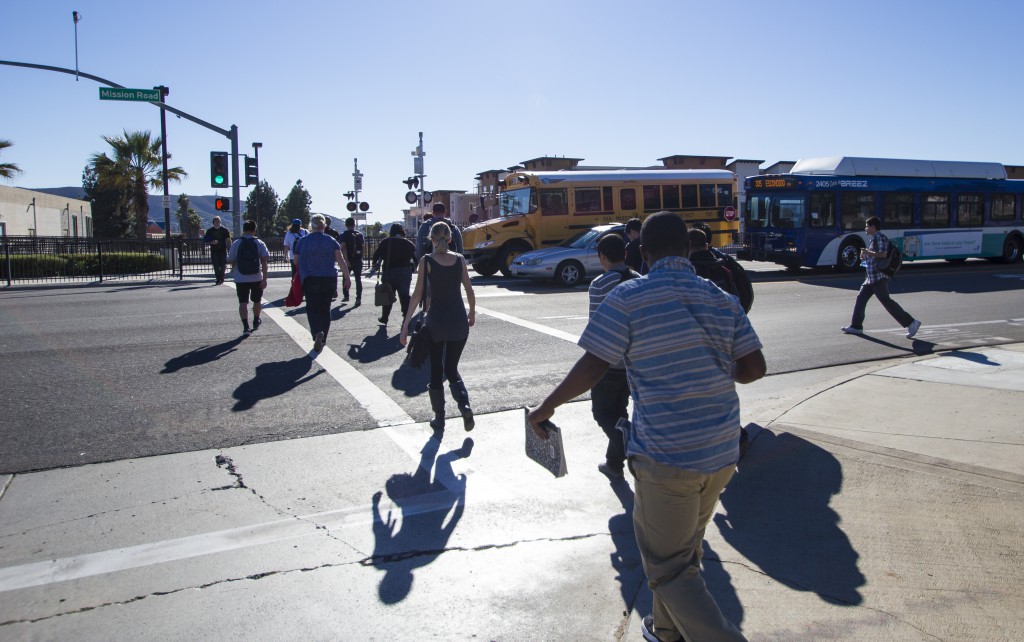The city of San Marcos is in the design phase of constructing a pedestrian bridge right outside the main entrance of Palomar College on West Mission Road, according to officials.
The construction project is one of many improvements and additions planned for the urbanization of the city with an emphasis on walkability and public transit.
The pedestrian bridge caught public attention with the city’s announcement of a $300,000 design contract awarded to Simon Wong Engineering in early 2013. Now almost two years later, students racing the red light across Mission Road to catch the Sprinter may wonder what happened.
The bulk of the work is being done behind the scenes where 30 percent of the design has been completed in partnership with the California Public Utilities Commission and North County Transit District, according to Deputy City Manager Lydia Romero.
The bridge was brought to the San Marcos City Council with the Palomar Station mixed-used development in 2006. That includes a Sprinter and bus stop across the street from Palomar’s main entrance. The transit center attracts hundreds of students who daily cross the busy, 4-lane Mission Road during high-traffic times.
While the project was privately funded by developers and the bridge was an essential structure to continue the project, the developers propositioned the city to seek out a federal grant specific to the project. Due to the location of the pedestrian bridge, it helped secure a federal grant in 2009.
One of the conditions of this specific federal grant, according to the city’s Communications Officer Sarah Divan, is how transit-oriented the area is and in part due to the city’s drive to become pedestrian friendly.
Students who cross the street said the bridge is necessary to keep pedestrians safe.

“Because it is a transit center you see a lot of parents with their children,” said Sarah Jumper, a 29-year-old freshman at Palomar who rides both the Sprinter and the Breeze at the college transit center with her daughter. “It would be a lot safer (having the bridge) so you don’t have to wait so long for the light,” Jumper said.
Freshman Alendria O’Connor, 18, said she is a little wary of the project and doesn’t see a need since students generally cross the street altogether and that it would only “cause less traffic for the cars.”
However, Ramos counters that West Mission Road is a major thoroughfare for the city connecting Escondido, San Marcos and Vista to the rest of the county.
The heavy congestion and traffic on the street currently creates a dangerous environment for students who occasionally jaywalk to make it onto an arriving train. Romero said she has witnessed such a scene while riding the Sprinter.
O’Connor, who rides the Sprinter three times a week and said it’s a lot more convenient than driving with its location a mile away from her home, is a prime example of the cities initiative for pedestrian-friendly environments.
Divan said that the pedestrian bridge is safer for pedestrians and that that it will create more traffic efficiency where pedestrian traffic and automobile traffic won’t have to stop for the other.
While the pedestrian bridge is connecting the community to public transit from Palomar Station to Palomar College, it’s the beginning stages in how the city plans on urbanizing the city.
The city is in works to create a complete street on Armorlite Drive, just south of the Sprinter station, where the pedestrian friendly corridor will de-emphasize automobiles and emphasize other modes of transit, such as bikes and Segways. Armorlite will create an atmosphere where people will want to walk and get out of their cars, Romero added.
“It’s connecting the community and creating more opportunities to live, work and play in one space,” Divan said.
City officials added that the public can register with e-alerts on the city website, www.san-marcos.net/cip, to get automatic email updates and news releases on the project. The project is also available on Facebook and Twitter.
Image Sources
- Students Crossing Mission Road 2014: Gary West/The Telescope | All Rights Reserved

